Don’t take this the wrong way, there is nothing wrong with calling, emailing or even going door to door for sales purposes.
But let’s face it. Methods like these are nearly the thing of the past for the simple reason that they cannot scale and it’s guesswork at best.
Today, consumers have a different way of researching the product they want to buy. Digital communication and individual research are becoming more and more important.
No one wants to hear a pre-structured pitch about how great your new product is. They rather read reviews and posts to develop an opinion on their own.
And this is why SEO as part of an inbound marketing strategy is becoming increasingly important. Utilizing the power of the web, you will not only achieve a better promotion but also a long term relationship with your buyers.
We have compiled a list of tips that will help you create the ultimate system for lead generation. And with the right followup actions, these leads will be turned into paid customers with little to no additional effort.
How to qualify a lead
As opposed to cold calling and going door to door, you want to make sure that all your efforts are worth your time and investment
In other words, you want to make sure that you communicate with people that have an interest in your product.
Start by filtering out people that will not find value in your offer. Share on XThe world’s best car won’t be of any use if you don’t have a driver’s license.
Therefore, start by filtering out people that will not find value in your offer. The best way to do this is to target potential customers who have shown an interest in your product by submitting their personal information.
Here are a few ways to connect with potential customers:
-
Offer a webinar or free consultation
Ask all applicants for their personal information, including their email, so you can build rapport through email marketing. -
Giveaways or time-restricted discounts
People that tend to click through on offers like these are considered good leads. Make sure you get (at least) their email, in exchange for the offer. -
Enhance your blog posts
Make sure that all articles on your blog have some sort of lead magnet. Think about your customer and his needs and make sure the value you offer will offer a solution to one or more of his problems.
Now that you have an idea of the different paths you can take, you need to optimize the content to ensure a continuous flow of incoming leads with minimal effort.
Creating sales content to get ready-to-buy leads
If you are reading this you probably already have some SEO knowledge. But you still seem to struggle when it comes to converting your leads to actual customers.
Am I right?
Don’t worry, I have been there too. And here are the steps I took to drive tons of qualified traffic to my blog posts, giveaways, and webinars:
1 Keyword research
Every good piece of content starts with a good keyword. And you won’t be able to find these unless you research what people are currently looking for.
Start with a topic that has a low difficulty score. This metric shows you how many existing articles are currently ranking for the specific keyword.
And by finding a keyword with a low difficulty score, you will also have the opportunity to write the best piece of content.
Difficulty score also helps you how many backlinks you’ll likely need to rank on the first page of Google. The calculation below will give you an idea of your link building efforts.
The difficulty scores range from 1-100. Here’s a quick look at what you can expect in terms of backlinks.
Difficulty score from:
- 1-10: <10 backlinks
- 10-20: 10-23 backlinks
- 21-30: 24-50 backlinks
- 31-40: 51-80 backlinks
- 41-50: 81-150 backlinks
- 51-60: 151-250 backlinks
- 61+: a lot of backlinks
2 Choosing a topic
The topic will naturally derive from your keyword research. To explain how this works we will illustrate with an example.
Imagine you have a new real estate company and you are looking to acquire more clients. The first step of the process is to find the top ranking real estate blogs on Google.
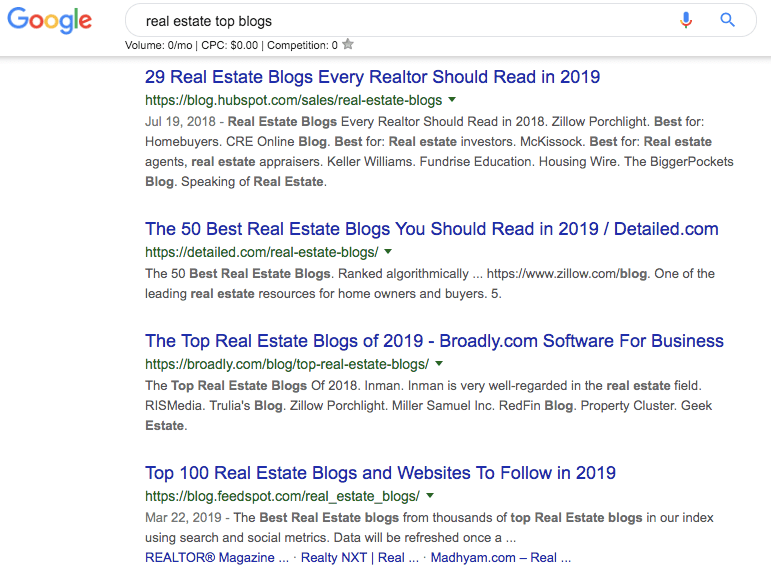
Explore the real estate blogs presented in the list posts and find a website that looks promising.
After choosing a real estate blog that looks interesting, copy its URL and check if you can discover some good topics with a low keyword difficulty score.
The best way to discover interesting topics is by utilizing the power of SEMrush.
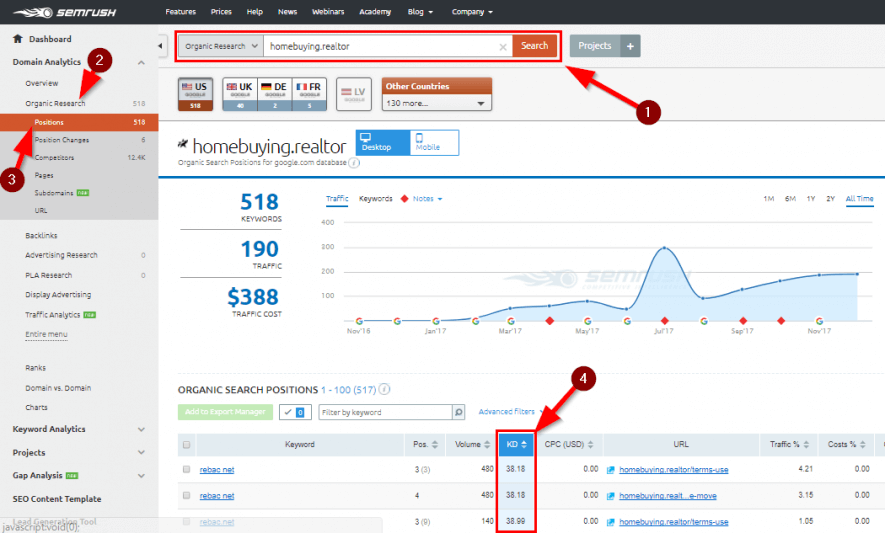
1: Head over to Organic Search and copy/paste the blog’s URL
2: Click on Organic Research
3: Select Positions.
4: Sort the keyword difficulty (KD) from lowest to highest and check for underutilized keywords and/or topics.
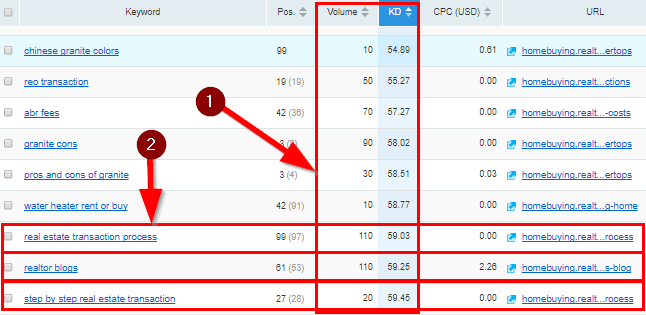
Step 1: Focus on keywords that have a search volume of 10-1000
Step 2: Cross-check your findings with a keyword difficulty score of 0-60
Within a few minutes, we found three interesting topics that fit our criteria. Now that we have that, we need to go ahead and find 3-4 related keywords.
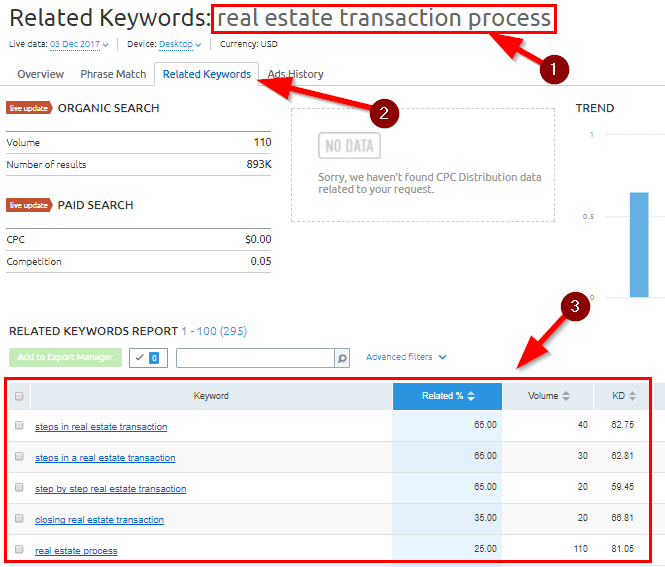
1: Click on the keyword that interests you
2: Go to the section “Related Keywords”
3: See all the synonyms for your keyword, including their KD and Volume.
Once you decide on your topic, its time to create the content.
3 Write and Optimize your Content
Start be reading similar articles to the topic you want to write about. Check what content already exists and which problems are already solved.
Note: Keep the best articles in a spreadsheet, you’ll need it later.
Your goal here is not to write the same stuff but rather to discover things that others may have missed.
Your goal?
To outrank your competitors by creating content that provides 10x more value to its readers.
Make sure the content is SEO friendly.
Once your content is created, you’ll have to improve its on-page optimization. This is the only way to ensure that the content will eventually have its spot in the first page of Google.
Here is a checklist with the 10 most important on-page SEO tips.
- The H1 headline should start with or include your focus keyword.
- Make sure your headline does not exceed the 70-character limit.
- Consider adding clickbait keywords in your Headline – best, top, awesome, Crazy, etc.
- Add images which include the keywords as Alt-tags.
- And Add your focus keyword within the first 50 words.
- Add a few related keywords within the content.
- Make sure your keyword represents 0.5% to 1% of your content.
- Add the keyword in your URL.
- Add the focus Keyword in your Meta-description and SEO title.
- Include your focus keyword in the sub-headings.
If you follow these rules and create an outstanding article (at least 1,000-1,500 words), your content will be ready for backlinks.
Keep these tips in mind and write a 2000+ words article. After that, you are ready to work on your link building strategy.
4 Develop a backlink strategy
Backlinks are where the real game is played. Your article may be the best on its topic, but it won’t rank if it doesn’t have some sort of authority.
Google measures this authority by the number of backlinks your page has. More backlinks lead to higher importance and, thus, a higher rank in the SERPs.
Remember the spreadsheet with the best articles on your topic? It’s time to make use of the list.
The goal of this step is to discover and “steal” our competitors’ backlinks.
We do this by finding pages that link with the posts you found and asking them if they would consider replacing their current resource, with your resource.
And the best way to get a good overview of your competitors’ backlinks is by using Linkody.
1: Sign up for a free 30-day trial
2: Click on ADD DOMAIN in the Dashboard
3: Input the domain URL for each one of your competitors, make sure the checkbox “Automatically discover backlinks” is selected and click on ADD DOMAIN
4: Once the domain is added you can do either of two things:
– Click on Links to see the total amount of Backlinks that lead back to your competitor
– Or, Click on Landing pages, scroll to find the specific URL you have on your list and check the backlinks that lead to that page specifically.
In both instances, you will get very useful information on your competition and you will be able to create a strategy to outrank them.
5: Next, export the URLs you want to reach out to and find their email addresses using a tool like hunter.io.
Usually, with well-structured email outreaches, your chances of getting a backlink are quite high.
From there, your communication skills and your industry will determine how many of those emails will actually turn into backlinks.
5 Create a lead magnet and a CTA
Now, your article is published and your backlinks are piling up. That’s awesome news. Google should be moving you closer to the first page of Google.
If that’s the case, its time to actually create a funnel that will help us collect the contact information, or at least the email, of our potential clients.
Don't ask for contact info directly, but have them give it to you willingly to receive a free, downloadable Lead Magnet. Share on XThe trick here is not to ask for it directly, but rather have them give it to us willingly in order to receive a free, downloadable Lead Magnet.
A lead magnet is a form of content, whether written or audiovisual, that helps a potential customer solve one or more of his problems.
Since your keyword research will result in traffic from qualified leads, the goal here is to have as many of them to download the lead magnet as possible.
Offer something valuable and you are guaranteed to receive your reader’s contact information in return.
Creating a call to action
Have you ever clicked on an interesting article and, while reading, suddenly a pop-up window jumps to the front of your screen, offering a resource that you could really use?
This resource is our lead magnet and the pop-up box is the call-to-action.
There are several types of CTAs that you can choose to better capture leads.
Here are some ideas to ignite your creativity.

This type of CTA comes in handy when your audience has a very specific need. Add a very specific description with numbers you can back through case studies and make your offer irresistible with a Free Bonus.
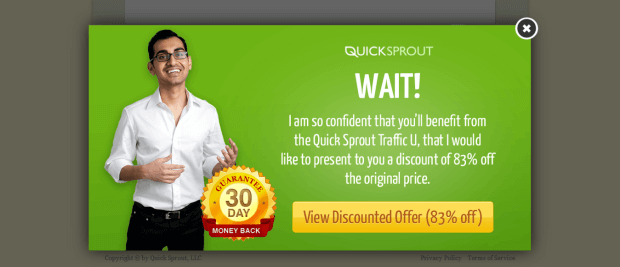
Once a visitor has decided to leave your page, there is almost nothing that can keep him interested. If you have a high bounce rate on your lead capture page you will need an exit intent CTA.
Especially with info products, offering a large discount will come in handy and not affect your business in a negative way.

If your Analytics show you that readers spend little time on your page, a welcome mat pop-up is a great strategy to capture leads.
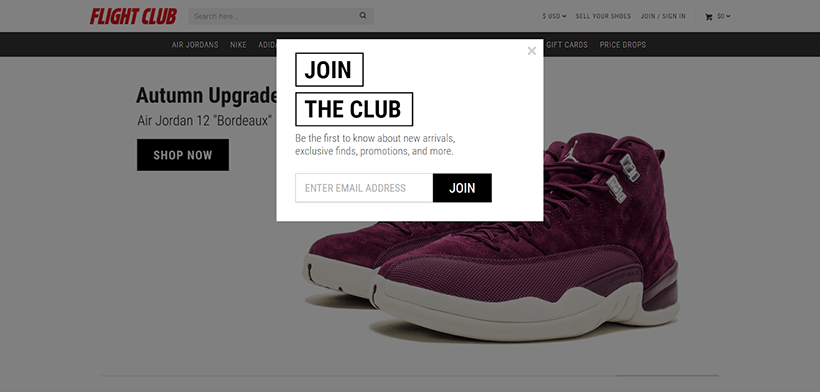
CTAs don’t have to be crowded. Sometimes, your visitors will instantly identify with your message, even with only a handful of text.
Learn how to add your CTA to your page by reading this guide.
Now it is your turn
You finally know how to turn page visitors into paid customers. From here it is up to you to apply your newly acquired knowledge.
Let’s have one last recap of the things we learned:
- Research your topic carefully
- Through SEMrush, select a keyword with a search volume of 10 to 1000 and a keyword difficulty score from 0 to 60.
- Optimize your on-page SEO before you publish the article.
- Conduct an email outreach in order to collect new backlinks.
- Finally, create a lead-magnet and add it to your page with a strong CTA.
And that’s it, folks — now you have a funnel for capturing new leads.
Want to help contribute to future articles? Have data-backed and tactical advice to share? I’d love to hear from you!
We have over 60,000 monthly readers that would love to see it! Contact us and let's discuss your ideas!

